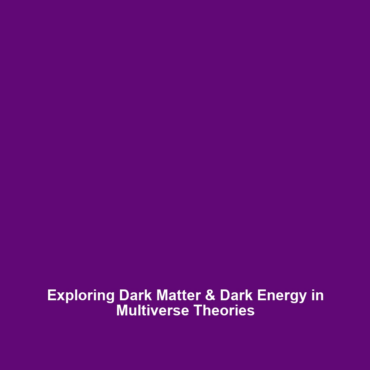Dark Matter & Dark Energy in the Multiverse Theories
Introduction
Dark matter and dark energy are two of the most enigmatic components of our universe, constituting approximately 95% of the cosmos. In the realm of multiverse theories, these phenomena take on additional significance, providing new frameworks to understand the fabric of space-time. This article delves into how dark matter and dark energy interact within the context of multiverse theories, illuminating their roles and implications. Understanding these complex interactions is crucial for advancements in cosmology and theoretical physics.
Key Concepts
Understanding Dark Matter
Dark matter refers to the unseen matter that does not emit, absorb, or reflect light, making it invisible and detectable only through its gravitational effects. It is believed to play a pivotal role in the formation of galaxies and the large-scale structure of the universe.
The Role of Dark Energy
Dark energy is a mysterious force that is driving the acceleration of the universe’s expansion. It counteracts the gravitational pull of matter, leading to a dynamic interplay that is fundamental to our current understanding of cosmological principles.
Multiverse Theories
Multiverse theories postulate the existence of multiple, perhaps infinite, universes, each with different physical constants and laws of nature. This concept challenges and extends the traditional understanding of dark matter and dark energy by suggesting that our universe could be just one of many, with varying properties and compositions.
Applications and Real-World Uses
The study of dark matter and dark energy in multiverse theories has potential real-world applications in several areas:
- Astrophysics Research: Enhancing models of galaxy formation and evolution.
- Technological Innovations: Development of advanced sensors for detecting cosmic phenomena.
- Philosophical Implications: Providing a broader context for the nature and origins of existence.
Understanding how dark matter and dark energy operate within multiverse theories improves our capabilities in these fields.
Current Challenges
Despite the fascinating nature of dark matter and dark energy, there are several hurdles faced by scientists:
- Detection Limitations: Current technology struggles to directly detect dark matter particles.
- Theoretical Disputes: Conflicting models and interpretations lead to uncertainty in predictions.
- Computational Complexity: Simulating multiverse scenarios requires immense computational resources.
Future Research and Innovations
The future of research related to dark matter and dark energy in multiverse theories holds numerous possibilities. Upcoming breakthroughs could include:
- Advanced Particle Detectors: New technologies may enable detection of dark matter particles.
- Collider Experiments: Facilities like the Large Hadron Collider could provide insights into dark matter’s properties.
- AI in Cosmology: Artificial intelligence may enhance data analysis techniques in astrophysics.
Conclusion
Dark matter and dark energy in the framework of multiverse theories represent frontier topics in modern physics. Their importance extends beyond theoretical implications, influencing our understanding of the universe itself. As research progresses, new insights are expected to unfold, potentially transforming our comprehension of cosmic phenomena. For further reading, check out our articles on Dark Matter and Dark Energy.

